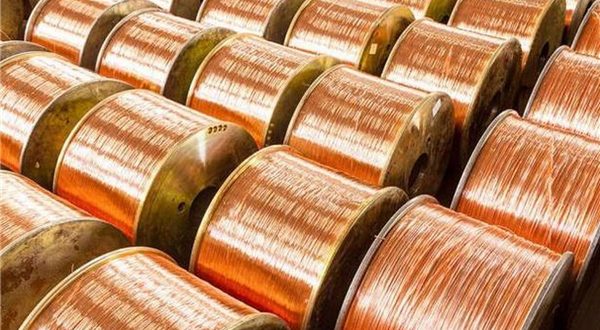The National Iranian Copper Industry Company (NICICO) announced that it has registered a higher demand than current supply and output levels in the country. reminding that the fast-growing sector is disappointing US-imposed sanctions against Tehran’s metal industries.
For the first time in the history of the country’s copper industry the sales of NICICO have outpaced the amount of output. said CEO of the NICICO Ardeshir Sa’ad Mohammadi on Sunday. adding that this is despite a series of American sanctions that seek to stifle Iran’s lucrative trade of metals.
The comments come amid an unprecedented boom in Iran’s metals and mining sector as the country seeks to diversify the economy away from oil.
Sa’ad Mohammadi said another reason for Iran’s booming copper exports is a surging demand in the international markets as the precious metal is being increasingly used in industries that are gearing toward electrification.
The NICICO chief said that more than 310 million euros had been spent on a massive copper production site that will come on line within the next few months. He said the project. located in an area some 80 kilometers to the West of Kerman. includes a smelter. an oxygen facility. an acid production unit and a warehouse.
Early in this month. a report was out showing that a total sum of $3 billion was slated to be invested in the copper industry of Iran as the country is eyeing a bigger share in the international market of the precious metal.
The report recounted that more than $3 billion will be invested in various copper industry projects across Iran in the next 5 years. allowing the country to be more competitive and have a better share of an international market that is facing a surging demand for the precious metal.
The report quoted the head of IMIDRO. Iran’s largest metals and mining sector group. as saying that the country was aiming to increase both the output and the resource discovery activity in the copper sector.
Khodadad Qaribpour said more than $120 million had been spent on a major project finished earlier this year to produce 610.000 tons of sulfuric acid. a key ingredient and by-product in copper production. each year.
Qaribpour said activity was surging at three main copper hubs in southeast and northwest of Iran.
Iran’s metals sector has seen a rapid expansion over the past two years as the government seeks to offset the impacts of a series of American sanctions on revenues that were once derived from oil.
The United States has targeted Iran’s trade of metals with a series of bans since May this year although experts believe the sanctions will fail to affect the current boom in production and exports of various metals from the country.
Last month. Sa’ad Mohammadi had said that around $1 billion had already been invested in mining and production of copper in the East Azerbaijan province. a center of industry and business near the Iranian-Turkish border.
Sa’ad Mohammadi said that the investment plans were aimed to allow Iran raise its share of copper exports to Turkey. a country he said is importing 500.000 tons of copper cathode from Uzbekistan and Kazakhstan each year.
Sa’ad Mohammadi said NICICO’s main objective was to enable the copper industry in East Azerbaijan to capture at least 20 percent of Turkey’s import market within the next two years.
He added that main copper projects introduced in the region included a smelter. a refinery and a third phase of concentrate production at the sprawling Sungun Mine. the largest open-cast copper mine in Iran located around 150 kilometers from the provincial capital of Tabriz. Iran’s sixth largest city.
Iran is tapping into its mines and metals deposits like never before as it feels the pressure of the American sanctions that have hampered its access to normal oil revenues.
That comes as the United States has specifically targeted Iran’s trade and production of metals with a series of bans since May this year.
Experts believe the sanctions would fail to stifle Iran’s growth in the sector as customers have used third countries for imports of metals from Iran.
Sa’ad Mohammadi said development of the copper industry in Northwest Iran was an urgent necessity given the rising demand for the metal in the world.
He said the European Union had identified copper as a primary field for investment mainly because of the demand that would be created as a result of electrification in the automotive industry.
The senior industrialist said a maximum of 20 kilograms of copper is used in the production of normal cars. adding that the figure increases fourfold to 80 kilograms in the electric cars.
Late in June. Bahram Shakouri. a member of Iran’s Copper Association. said that the United States` unilateral sanctions against Iran have failed to block export of copper from the country. adding that Iran plans to increase its annual production of copper cathode to 450.000 tons.
Shakouri said on June 29 that the country exported more than $1 billion worth of copper cathode. a basic product widely used in various industries. in the last Iranian calendar year which ended in March 2019.
Shakouri said sanctions imposed on Iran have only restricted the country’s ability to directly ship its copper to traditional destinations like Europe. Japan and South Korea. adding that China is currently Iran’s main copper customer. and export to other destinations is carried out via third countries.
Back in mid-February. Iran announced that it had produced more than 200.000 tons of copper cathode in the 10-month period between March 21. 2018 and January 21. 2019. indicating a 61% growth compared with corresponding period in the year before.
Another statistical report showed that Sarcheshmeh Refinery Unit in Kerman province produced 117.643 tons of copper cathode in the same period. recording a significant 147 percent growth in a year-on-year comparison.
Sarcheshmeh Refinery Unit accounted for approx. 59 percent share of country’s total copper production volume.
Likewise. copper anode production volume from March 21 – Jan. 21 hit 257.833 tons. showing a considerable 68 percent growth as compared to the last year’s corresponding period.
 Iran Energy News Oil, Gas, Petrochemical and Energy Field Specialized Channel
Iran Energy News Oil, Gas, Petrochemical and Energy Field Specialized Channel




